By Darren E. Collins
During excavation work in August 2021, a construction worker was pinned between the rubber track of an excavator and the lip of the trench in which he was working. The excavation site was in the rear parking area of a mixed-use building. The worker was outside of the protective trench shield. This rescue was complicated since the worker’s head was touching both the excavator’s track and the trench lip. He was unable to move his upper torso (photo 1).

(1) In this aerial view of the scene, the rotator (middle) and the forestry crane (upper left) are stabilizing the compact excavator. (Photo by Paula Mickan.)
- Trench Rescue: Controlling Soil
- Three Essentials for Trench Rescue Success
- TRENCH RESCUE LESSONS LEARNED
- TRENCH RESCUE: THE BASICS
At 1226 hours, the Lakewood (OH) Fire Department received a call for a male “crushed by a construction vehicle.” The following units were dispatched: Medic 3 (M3), Engine 3 (E3), Truck 1 (T1), and Medic 1 (M1); our command vehicle (C2) self-dispatched. The initial dispatch reported that the worker was deceased; an update informed responding units that the reporting party believed the worker is “a little responsive but they think he’s going into shock.” En route, command asked dispatch if the worker was underneath the vehicle or if the vehicle was still on him in some way. Dispatch advised that a local tow company was on the way and the victim was still underneath the vehicle. The response was upgraded to have our rescue engine (E2) respond and stage on Detroit Avenue. The incident occurred near the intersection of Detroit and Thoreau Avenues.
Arrival and Size-Up
E3 and M3 were the first units to arrive on scene at 1230 hours. The engine captain confirmed that an excavator had collapsed into the trench workers had been digging. The trench was approximately three feet deep (photo 2). At 1231 hours, C2 arrived on scene and established command. Dispatch notified command that neighboring Westlake Fire Department had a trench rescue trailer if needed; command requested the trailer to respond to the scene. At this point, command wanted to confirm and advise dispatch that a large highway wrecker/rotator was needed at the scene.
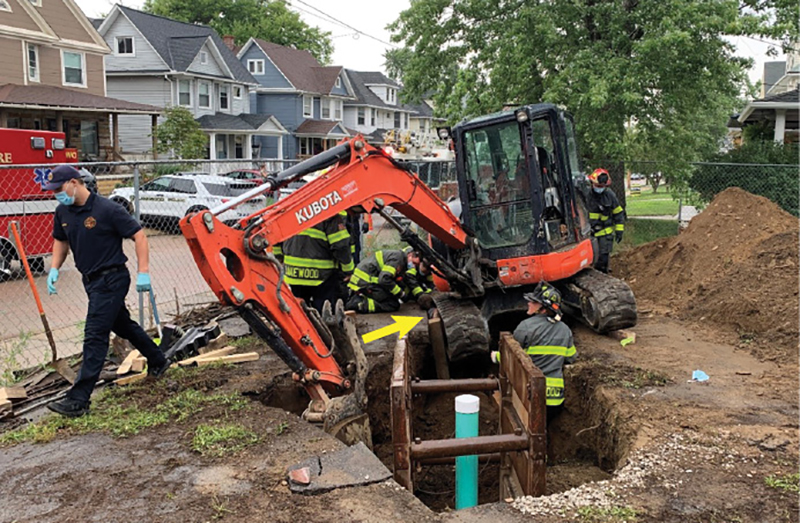
(2) Initial rescue personnel on scene assess the worker (arrow) and establish a rescue plan. (Photo by Zachary Wiles.)
In the early stages of the incident, there was too much radio traffic on our main radio channel. Most of this dealt with getting additional cribbing to the scene. Command announced priority radio traffic only; this was adhered to the entire incident.
The E3 captain provided command with his initial scene size-up. Prior to our arrival, trench work for a drain line was occurring in the rear parking lot of a mixed-use building. A trench box was in place at the south end of the trench and a spoil pile was located at the northeast area of the trench. The approximately 12,500-pound excavator, which had been positioned partially on the spoil pile, slid into the trench when the east trench wall collapsed. The excavator’s track pinned a worker to the west trench wall. The excavator was still running on arrival. The E3 officer instructed another worker to turn off the excavator without climbing onto it (photo 3).
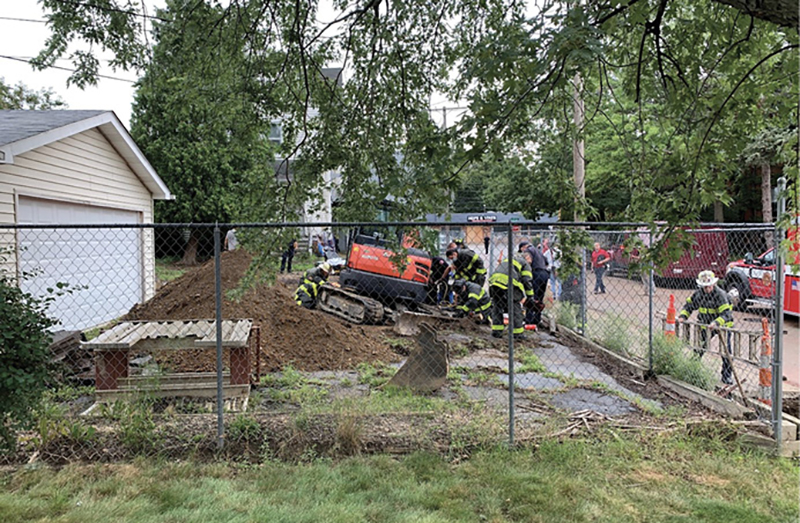
(3) A view of the incident looking south. (Photo by Zachary Wiles.)
The worker in the trench, pinned between the west wall of the trench and the excavator track, had some range of motion with both arms. His head was pinned between the asphalt trench lip and the upper part of the excavator track. The lower part of the track was touching his right torso around the area of his liver. At this time, responders could not see his legs, nor did they know the legs’ orientation. The worker was conscious and able to communicate with us. The rear lot was fenced in with a chain linked fence, which provided an initial perimeter (photo 4).
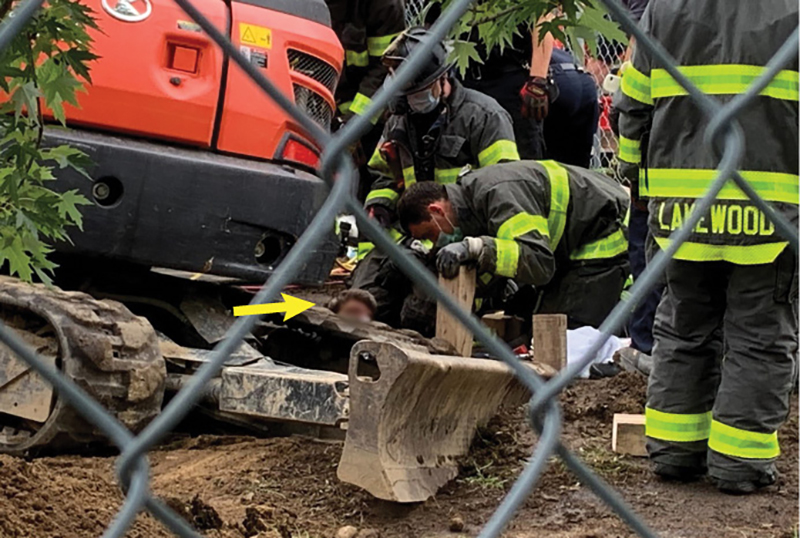
(4) The worker location (arrow) between the upper track and the lip of the trench. (Photo by Michael Matwijiw.)
Initial Action Plan (IAP)
Our IAP was to start cribbing to stabilize the excavator. Initially, 4 × 4 cribbing and wedges were placed to stop lateral movement of the excavator. Rescuers were trying to buy time until the wrecker/rotator arrived on scene. There was no room for error. Any movement resulting from further trench collapse or a shift of the excavator would immediately impact the patient. The emergency medical services (EMS) supervisor on M1 was placed in charge of the patient’s medical care. EMS administered normal saline intravenously on one of the patient’s exposed arms. The patient was alert and oriented. Tranexamic acid (TXA) was the only medication administered as a precaution shortly before the worker was extricated from the trench. TXA preserves the framework of the existing clot structure, preventing clot breakdown, according to “Medical Protocols,” Cleveland Clinic Foundation. It is intended to prevent or slow down (in this case) unseen possible internal bleeding. We could not visually fully assess the patient before he was extricated; his body from the neck down was not accessible. E3 and T1 continued to add cribbing to stabilize the excavator. Within minutes, the cribbing was captured and signaled the continuous slow movement of the excavator.
The action plan was updated to use air bags to move the excavator away from the worker with further stabilization using additional cribbing. Equipment was gathered to carry out this plan. Cribbing, air bags, and their control devices were placed behind rescue personnel on the west side of the trench. Fencing was removed from the west perimeter of the parking lot to improve trench accessibility for personnel and equipment and to clear a path to expedite removing the worker from the trench.
While rescuers were waiting for the wrecker/rotator, the patient and rescue personnel expressed concern regarding movement of the excavator even with the cribbing crews already had in place. Rescuers attempted to create space at the patient’s head. They had two options— remove asphalt and dirt at the west lip of the trench or cut the excavator track and try to remove it away from the patient’s head. Crews felt that removing asphalt and dirt from the lip of the trench would further destabilize the wall and any work to accomplish this would occur too close to the patient’s head. Crews attempted to remove the excavator track in an area away from the patient’s head with a reciprocating saw. Immediately, it was evident that this caused too much vibration and was discontinued.
Rotator and Crane Deployment
The wrecker/rotator operator arrived on scene at 1243 hours and was immediately briefed. Command advised him that the role of the rotator would be to further stabilize and hold the weight of the excavator. There was some discussion as to whether to just lift the excavator straight up or to push it away from the patient with the air bags. This would not be possible without injuring the patient because of the angle of the excavator relative to the patient’s body position and the questionable stability around the trench. The excavator had to be held both vertically and horizontally in a diagonal plane. This was clearly communicated to the rotator operator. From the screen of the rotator’s remote-control, he could determine how much weight the wrecker was holding and the reserve capacity left for lifting. This rotator had a 50-ton capacity. He communicated this to command, who advised him not to lift the excavator but only keep tension on the cables while the other rescuers would use air bags to move the machine away from the patient. Additional cribbing would capture any additional space gained (photo 5).
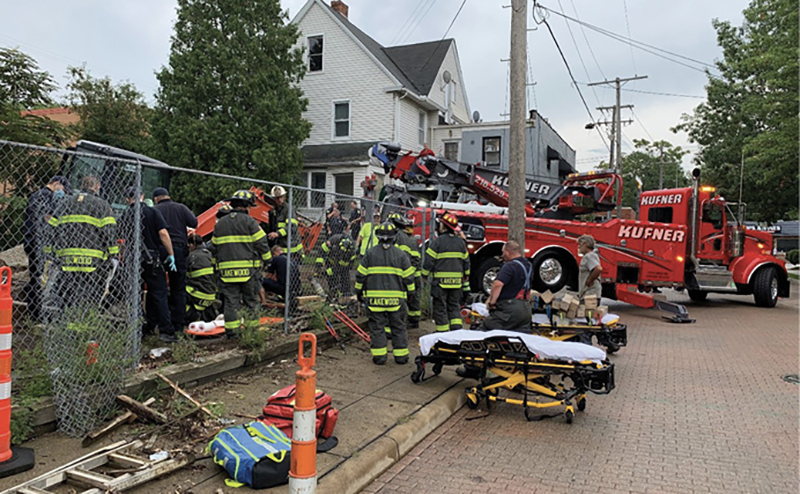
(5) The rotator on arrival; the operator was advised of the rescue plan. (Photo by Michael Matwijiw.)
At this point, the trench trailer and the Westlake Fire Department were still around 20 minutes away from the incident. When the trailer was still 10 minutes away, they received a brief operation description over the radio. Once the trench rescue team arrived on scene at 1259 hours, command provided the officer with a quick summary of the IAP. It was determined to continue with the current plan.
As an extra precaution to further stabilize any lateral movement of the excavator, command requested a public works forestry crane. The crane was set up at an adjacent property one lot over to keep this vehicle’s weight away from the trench. Rescue crews also removed the fencing and small trees from the east perimeter of the lot to improve the crane operator’s line of sight. A captain from the Fairview Fire Department (a mutual-aid department) was placed to oversee the setup of this part of the operation (photo 6).

(6) In the foreground, the forestry crane chains are attached to the excavator track on one side and the rotator chains are attached on the track on the other side and tensioned to prevent lateral movement of the excavator. (Photo by Zachary Wiles.)
Once the rigging was set up and the wrecker/rotator and forestry crane chains were tensioned, a communication plan was established between the crane and rotator operators and the personnel assigned to operate the air bags. The air bags were inflated no more than one inch at a time with constant communication among all operators (the rotator/crane operators and the air bag controllers). Other rescue personnel kept any other communication to a minimum. Additional cribbing was added as the air bags were inflated to support the excavator’s weight and to protect the patient while the rotator/crane operators maintained tension on the chains.
Pivoting the excavator’s track clockwise away from the patient’s body freed the patient’s upper body, allowing rescue personnel to dig his legs out. Rescuers found the patient’s upper body facing the excavator while his legs were oriented toward the west trench wall. His right leg was buried about up to his hip; his left leg was buried to the knee. Using their hands, rescue personnel removed dirt from around his legs until the worker was free enough to allow removal up and over the trench lip. There was not much room between the soil that collapsed and the bottom of the machine (photo 7).
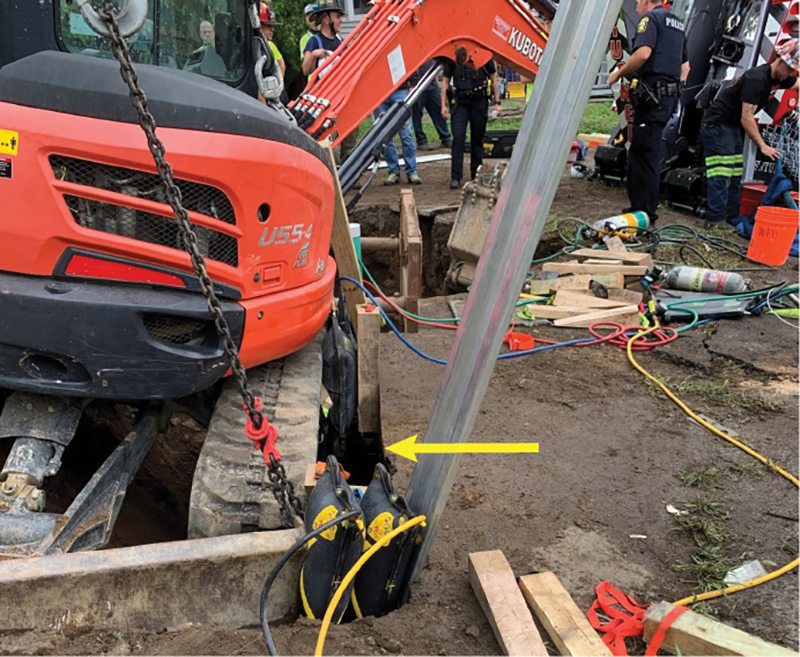
(7) After the worker’s removal; he was pinned in the space between the air bags (arrow). They were used with cribbing to create space. The chain is attached to the rotator. (Photo by Michael Matwijiw.)
At 1339 hours, care of the patient was transferred over to the Metro Life Flight medical team that was called earlier during the incident. The helicopter landed in the school parking lot, very close to the scene. With a great team effort, using multiple resources, the worker was freed approximately one hour from the time of dispatch. Since then, the patient has attended our yearly fire department memorial service the Sunday before Fire Prevention Week to thank the fire department and sent us a thank-you on Thanksgiving Day. He is truly grateful he is with us today.
Lessons Learned
Local resources. What potential emergency resources are available locally; what are their capabilities? Prior to this incident, our department had invited the towing company to bring its wrecker/rotator to our station. The operator discussed the rig’s capabilities and the type of equipment it carried. Before this training meeting, we had been unaware of this valuable resource; the operator training our personnel that day was also the same one who responded to this incident. This towing company also provides our department with nine cars each year (three per shift) for vehicle extrication training.
Incident command structure. This incident reminded us not to fear expanding the incident command structure. During our after-action review, a senior department member said he felt command should have expanded the command structure at this incident; I agree. Command was both in charge of the incident and in charge of operations. As a commander, if you do not expand the incident command structure, you will take on all roles as the incident commander. Command was able to keep track of all the moving parts of the incident, but if conditions rapidly changed, command’s ability to be nimble might have been impacted. Expanding the incident command structure would also assist with on-scene personnel accountability. At this incident, command limited the expansion to having a medical branch with the medical supervisor in charge of that branch.
Unified command. This was a perfect example of an incident that needed unified command. Our fire department gets along great with our police department; however, the departments do not regularly establish unified command. Since this incident, we have had an initial meeting with our police department to start practicing unified command even at routine incidents. The departments are looking to start regular meetings/training to increase familiarity of all personnel including officers across both departments. If we use unified command on a simple motor vehicle accident, even a quick mutual size-up and IAP will make coordination at a larger incident that much easier. Establishing unified command at one command post will hopefully be more common. Our city has the potential to respond to larger incidents involving an interstate, high-rise structures, rail traffic, the school district, and large community events. During this meeting. the police department also advised the fire department of a significant turnover of police officers and the need for fireground operations training with its new hires. Our fire department has done this regularly and it has allowed us to continually build bridges between the agencies.
The need for unified command was evident after reviewing the dispatch recordings. Using unified command would have decreased the amount of radio traffic; at times, both departments were providing the same updates to dispatch, asking dispatch or each other the same questions. If you limit your radio traffic and are concise, you have a better chance of hearing priority traffic such as “officer down” or “Mayday.”
Radio traffic. Radio traffic was an issue during the incident’s early stages—ancillary radio traffic involving bringing the appropriate apparatus and equipment to the site. E2 was using a backup engine that day, and the normal fire apparatus they would have used carried more cribbing and some additional equipment. Members discussing equipment/apparatus response should have been assigned to a different radio channel.
This was the most stressful incident of my almost 26 years with the Lakewood Fire Department. I cannot convey enough the fear that, if anything went wrong, like the excavator slipping for any reason, it would have probably killed the worker. The extra time it took to attach the forestry crane chain to the track felt like forever. But I deemed it necessary based on the position of the worker’s head relative to the angle of the excavator.
After he was extricated, I went back to the command vehicle and took a moment. A mutual-aid chief asked me if I was okay. I said yes; the tension you could have cut with a knife was gone. Later that night, bad storms came through our city, and we ran another 80 calls. I could not be prouder of my shift.
DARREN E. COLLINS has served since 1996 with the Lakewood (OH) Fire Department, where he is an assistant chief and the training officer. He has also served in the department as a paramedic, a hazmat technician, a vertical rescue technician, a fire instructor, and an intelligence liaison officer.

